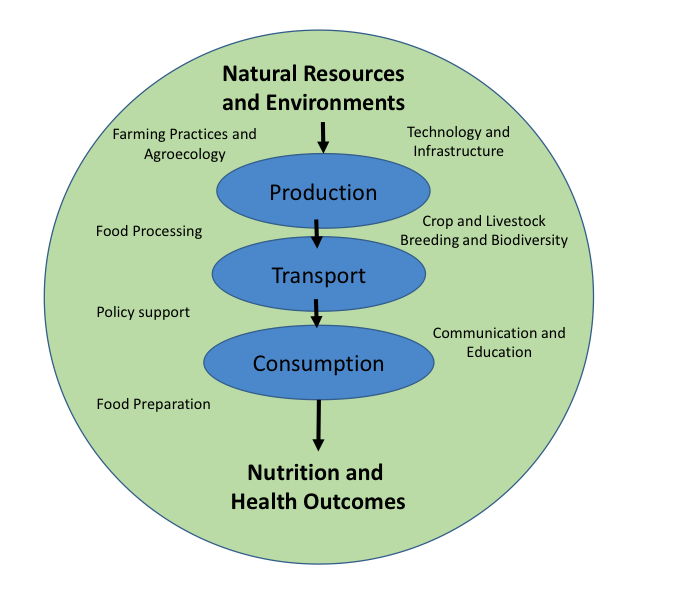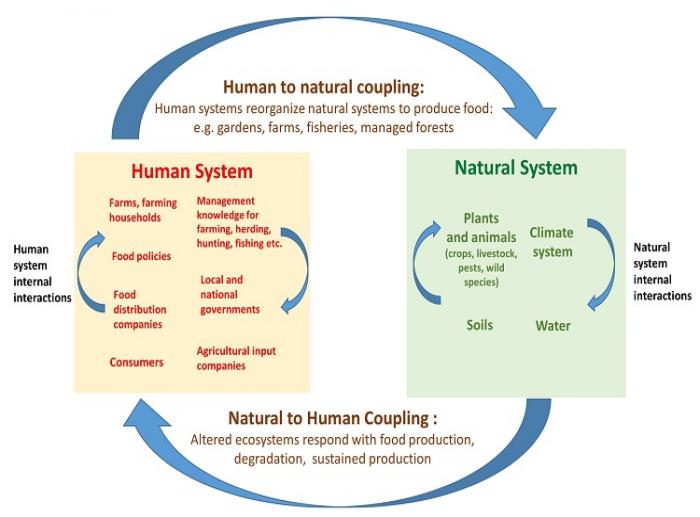Food Systems as Human-Natural Systems
Food System Examples from Household Gardens to Communities and Global Food Systems
Some of you in this course, perhaps even many of you, have had the experience of growing herbs or vegetables (Fig. 1.2.3) or keeping chickens for eggs or animals for meat. Although dwarfed by the enormous dimensions of the global food system, home food production is still a significant part of the food consumed by billions of earth's inhabitants. In other cases, small-scale fishing and hunting provide highly nutrient-dense foods, and coexist with modernized and industrial food systems, as any fishers and hunters in the class may be able to attest. These experiences of food production for personal or family consumption show natural-human interactions in a very simple way. To grow vegetables or hunt or raise animals means bringing together natural factors (seed, animal breeds, soil, water, fishing and hunting ranges, etc.) and also human factors (e.g. knowledge of plants, livestock, or wild animals, government policies) to gain access to food, as well as food storage and preparation, markets for tools and seeds, or human-built infrastructures like a garden fence or a chicken coop. This same interaction between natural and human factors is evident at a larger scale in the photo in Figure 1.2.4, which shows a landscape that has been transformed by a human community for food production.


Beyond these experiences of auto-sufficient food production and consumption, however, most of humanity also currently depends on global and local versions of the food system which features a web of suppliers, producers, transporters, and marketers that supply all of us as food consumers. Compared to gardening, catching trout, or keeping chickens, these food systems together form a far more complex version of the interactions between natural and human factors that produce and transport the food that we then consume as part of global and local food systems.
One way of viewing these regional and global food systems is that they can be divided by the type of activity in relation to food, and dividing them into components of food production, food transport, and food consumption (Fig. 1.2.5). Like other diagrams we've seen so far, this diagram can be considered a concept map showing relationships between the different components of a food system. The main arrows show the flow of food through the system from the managed natural environments used to produce food and the end result of nutrition and health outcomes. There are some unseen or implicit relationships here as well, like the way that farming practices, technology, communication and education, and other attributes of human societies support the functioning of a food system, and are included in the outer system boundary.

In addition to this more linear or "conveyer belt" portrayal of food systems delivering nutrition from natural resources, we may also be interested in thinking about the dramatic impacts humans have made on earth systems during the Anthropocene, discussed in module 1.1. In that light, we know that these natural systems may either be sustained or degraded by management, an important response that either maintains or undermines the entire food system. For this purpose, we may be interested in a food system diagram that makes the interactions among human and natural systems very explicit. Below in figure 1.2.6 is a version of a Coupled Human-Natural Systems diagram -- again, a concept map of sorts -- developed by an interdisciplinary group of social and environmental scientists (Liu et al. 2007) to represent the human-environment interactions in food systems.

This diagram highlights internal interactions within both the natural and human components of the food system. The natural components of food systems shown here are those we will tackle first in the first part of the course, while the latter half of the course will address the human system aspects of food systems and human-environment interactions shown as the large arrows connecting these two major components. As we saw in comparing home garden production, smallholder production landscapes and global food production chains above, food systems and their components are highly varied. However many similarities apply across the different components, actors, and environments of the food system:
- Food systems modify the natural environment and capture the productivity of the earth’s natural systems to supply food to human populations. Globally they create huge changes in the earth’s surface and its natural populations and processes.
- As portrayed in Figure 1.2.6, despite their complexity, food systems often involve coupling between human management and the response of natural systems. As pointed out by author Colin Sage in Module 1.1, the response of natural systems to human management can create sustainability challenges in food systems.
- Food systems involve the production, transportation, distribution, and consumption of food (Figure 1.2.5). The scale of these three processes can differ among food systems, which can be local, regional, and global.
- Food systems are examples of complex systems: they involve many interacting human and natural components, as well as important variability, for example, droughts, soil erosion, population changes, and migration, and changing policies. All of these affect the natural and human systems and can disrupt simple cause and effect relationships, in spite of the large-scale drivers and feedbacks shown in figure 1.2.6.
